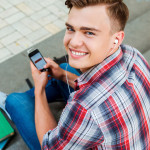 When you’re listening to music with headphones or earbuds, do people around you ever complain because they can hear your music, too? After a pop or rock concert, do you walk out with a ringing sensation in your ears that doesn’t go away for hours? Enjoying music is great, but listening with the volume way up high may leave you at risk for noise-induced hearing loss (NIHL).
When you’re listening to music with headphones or earbuds, do people around you ever complain because they can hear your music, too? After a pop or rock concert, do you walk out with a ringing sensation in your ears that doesn’t go away for hours? Enjoying music is great, but listening with the volume way up high may leave you at risk for noise-induced hearing loss (NIHL).
How does hearing damage happen?
Part of the inner ear, called the cochlea, has tiny hair cells that change sound into a signal that is sent to your brain. Hearing damage occurs when the hair cells are destroyed by loud noise. Once the damage is done it’s permanent. It cannot be fixed with medicine or surgery.
There are two ways that NIHL hearing loss can happen:
- Exposure to one really loud sound, such as an explosion. The sound is so loud that it can cause damage almost instantly
- Repeated exposure to loud sounds that last a long time, for example: listening to music on your phone or an iPod (or other portable device with earbuds) at a high volume every day. This damages the tiny hair cells in the ear over a period of time, and the hearing loss happens gradually.
Can my portable music devices cause hearing damage?
Yes. Devices such as your cellphone or iPod (used with earbuds) create sound levels that can cause hearing loss if they are used at high volumes for long periods of time.
Here are ways you can protect your hearing and still listen to music on your portable music device:
- Set the volume in a quiet place, and to a level where you can still carry on a conversation.
- Don’t turn the volume up when you go outside.
- Never listen to your portable music device at the maximum volume level.
- If you plan to listen for over one hour, the volume should be turned down below 60%.
- If sound from your headphones can be heard by people near you, the volume is too loud.
Other ways to protect your hearing:
- If you can’t lower the noise around you, move away from it.
- Wear earplugs or other protective devices when involved in a loud activity.
- Be aware of hazardous noise in your environment.
- Have you hearing tested if you think you might have hearing loss.
How can I lower my hearing loss at concerts?
To prevent damage at a loud concert, you should wear ear plugs. You might think you’d only need them when you’re at a rock concert, or up close to the stage or speakers, but the truth is that the type of music doesn’t matter – and neither does your distance from the stage (although being close to the speakers can mean you are being exposed to higher levels of noise). Sit at least 10 feet from the speakers. Research has shown that sound pressure levels appear equally hazardous in all parts of a concert hall.
Even though wearing earplugs might not seem like the coolest thing to do, keep in mind that some of your favorite band members wear them while performing. Many musicians perform every night for years, and that is a lot of noise to handle. Smart musicians and concert goers know that extremely loud noise can cause tinnitus (the sensation of “ringing in the ears”), and permanent hearing loss.
How do I know what’s too loud?
Sound is measured in units called decibels (dB). Generally, sounds that are louder than 80 dB can damage your hearing.
Here is a noise chart to help you better understand the difference between normal, loud, and dangerously loud noises.
Normal:
- 2-30 dB: a whisper
- 40-60 dB: a normal conversation
- 85 dB: noise from heavy traffic
Very loud:
- 95 dB: passing motorcycle
- 105 dB: Portable music device at maximum volume or a loud concert
Dangerously loud:
- 120 dB: sirens
- 150 dB: fireworks 3 feet away
According to the Centers for Disease Control and Prevention (CDC) about 5.2 million children and adolescents between the ages of 6-19 years old have a permanent hearing loss from repeated exposure to loud noise. Don’t become a statistic – be safe while listening to music.
Source: Read Full Article





